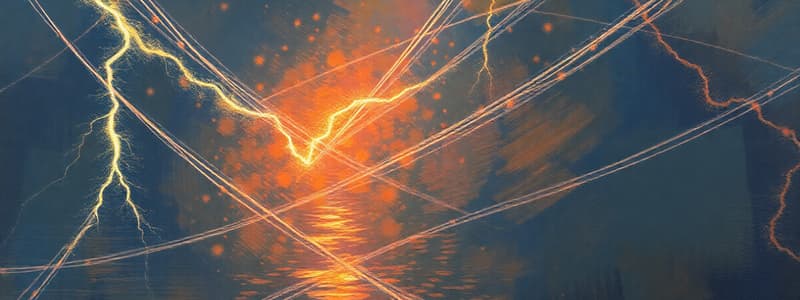Podcast
Questions and Answers
A proton is moving with a velocity $v$ in a uniform magnetic field $B$. Which of the following scenarios results in the minimum magnetic force on the proton?
A proton is moving with a velocity $v$ in a uniform magnetic field $B$. Which of the following scenarios results in the minimum magnetic force on the proton?
- The proton moves parallel to the magnetic field. (correct)
- The proton moves perpendicular to the magnetic field.
- The proton moves at an angle of 60 degrees to the magnetic field.
- The proton moves at an angle of 45 degrees to the magnetic field.
A copper wire carries a steady current. Which of the following changes will definitely increase the strength of the magnetic field around the wire?
A copper wire carries a steady current. Which of the following changes will definitely increase the strength of the magnetic field around the wire?
- Decreasing the length of the wire.
- Increasing the current in the wire. (correct)
- Increasing the diameter of the wire.
- Replacing the copper wire with an aluminum wire.
A transformer is used to step down the voltage from 240 V to 12 V. If the primary coil has 1000 turns, how many turns does the secondary coil have?
A transformer is used to step down the voltage from 240 V to 12 V. If the primary coil has 1000 turns, how many turns does the secondary coil have?
- 20
- 50 (correct)
- 480
- 120
Which of the following statements accurately describes the relationship between electric fields and equipotential surfaces?
Which of the following statements accurately describes the relationship between electric fields and equipotential surfaces?
A parallel plate capacitor is connected to a voltage source. What happens to the electric field between the plates if the distance between the plates is doubled while the voltage remains constant?
A parallel plate capacitor is connected to a voltage source. What happens to the electric field between the plates if the distance between the plates is doubled while the voltage remains constant?
Which of the following is a correct statement regarding electromagnetic waves?
Which of the following is a correct statement regarding electromagnetic waves?
In a series circuit with three resistors, $R_1 = 10 \Omega$, $R_2 = 20 \Omega$, and $R_3 = 30 \Omega$, connected to a 12 V battery, what is the current flowing through the circuit?
In a series circuit with three resistors, $R_1 = 10 \Omega$, $R_2 = 20 \Omega$, and $R_3 = 30 \Omega$, connected to a 12 V battery, what is the current flowing through the circuit?
Which of the following regions of the electromagnetic spectrum has the shortest wavelength?
Which of the following regions of the electromagnetic spectrum has the shortest wavelength?
A solenoid is designed to produce a strong magnetic field. Which of the following modifications would NOT increase the magnetic field strength inside the solenoid?
A solenoid is designed to produce a strong magnetic field. Which of the following modifications would NOT increase the magnetic field strength inside the solenoid?
According to Lenz's Law, what determines the direction of the induced current in a circuit due to a changing magnetic flux?
According to Lenz's Law, what determines the direction of the induced current in a circuit due to a changing magnetic flux?
Flashcards
Electromagnetism
Electromagnetism
Fundamental force combining electric and magnetic phenomena.
Resistance
Resistance
Opposition to the flow of electric current.
Electric Field
Electric Field
Region around a charge where electric force is exerted.
Magnetic Field
Magnetic Field
Signup and view all the flashcards
Faraday's Law
Faraday's Law
Signup and view all the flashcards
Lenz's Law
Lenz's Law
Signup and view all the flashcards
Electromagnetic Waves
Electromagnetic Waves
Signup and view all the flashcards
Electromagnetic Spectrum
Electromagnetic Spectrum
Signup and view all the flashcards
Electric Circuit
Electric Circuit
Signup and view all the flashcards
Ohm's Law
Ohm's Law
Signup and view all the flashcards
Study Notes
- Electromagnetism is one of the four fundamental forces of nature, encompassing electric and magnetic phenomena.
Core Concepts
- Electric charge is a fundamental property of matter, with positive and negative types.
- Like charges repel, and opposite charges attract.
- The SI unit of electric charge is the coulomb (C).
- Electric current is the rate of flow of electric charge, measured in amperes (A).
- Voltage (electric potential difference) is the electric potential energy difference per unit charge, measured in volts (V).
- Resistance is the opposition to the flow of electric current, measured in ohms (Ω).
- Magnetism is a force caused by the motion of electric charges.
- Magnetic fields are created by moving electric charges and magnetic materials.
- Magnetic fields exert forces on moving electric charges and magnetic materials.
- Electromagnetism describes the interaction of electric and magnetic fields.
- Electromagnetic waves are disturbances in electric and magnetic fields that propagate through space.
Electric Fields
- An electric field is a region of space around an electric charge where a force would be exerted on other electric charges.
- Electric field lines represent the direction and strength of the electric field.
- Electric field lines originate from positive charges and terminate on negative charges.
- The electric field strength (E) is defined as the force per unit charge, measured in newtons per coulomb (N/C).
- The electric field due to a point charge is given by Coulomb's law: E = kQ/r², where k is Coulomb's constant, Q is the charge, and r is the distance from the charge.
- Electric potential (V) is the electric potential energy per unit charge, measured in volts (V).
- The electric potential difference between two points is the work done per unit charge to move a charge between those points.
- Equipotential surfaces are surfaces where the electric potential is constant.
- Electric fields are always perpendicular to equipotential surfaces.
Magnetic Fields
- A magnetic field is a region of space around a magnet or moving electric charge where a magnetic force is exerted.
- Magnetic field lines represent the direction and strength of the magnetic field.
- Magnetic field lines form closed loops; they do not begin or end at a point.
- The magnetic field strength (B) is measured in teslas (T).
- The magnetic force on a moving charge is given by F = qvBsinθ, where q is the charge, v is the velocity, B is the magnetic field strength, and θ is the angle between the velocity and the magnetic field.
- The direction of the magnetic force is perpendicular to both the velocity and the magnetic field (right-hand rule).
- A current-carrying wire produces a magnetic field around it.
- The magnetic field due to a long, straight wire is given by B = μ₀I/(2πr), where μ₀ is the permeability of free space, I is the current, and r is the distance from the wire.
- Solenoids and toroids are used to create uniform magnetic fields.
Electromagnetism
- Electromagnetism combines electric and magnetic forces into a single fundamental force.
- Faraday's law of induction states that a changing magnetic field induces an electromotive force (EMF) in a circuit.
- The induced EMF is proportional to the rate of change of magnetic flux: EMF = -N(dΦ/dt), where N is the number of turns in the circuit and Φ is the magnetic flux.
- Lenz's law states that the direction of the induced current is such that it opposes the change in magnetic flux that produced it.
- Maxwell's equations are a set of four equations that describe the behavior of electric and magnetic fields.
- Maxwell's equations predict the existence of electromagnetic waves that propagate at the speed of light.
- Electromagnetic waves are transverse waves consisting of oscillating electric and magnetic fields perpendicular to each other and to the direction of propagation.
Electromagnetic Spectrum
- The electromagnetic spectrum is the range of all possible frequencies of electromagnetic radiation.
- From lowest to highest frequency (longest to shortest wavelength), the electromagnetic spectrum includes: radio waves, microwaves, infrared radiation, visible light, ultraviolet radiation, X-rays, and gamma rays.
- Radio waves are used for communication, broadcasting, and radar.
- Microwaves are used for cooking, communication, and radar.
- Infrared radiation is associated with heat.
- Visible light is the portion of the electromagnetic spectrum that is visible to the human eye.
- Ultraviolet radiation can cause sunburn and skin cancer.
- X-rays are used for medical imaging.
- Gamma rays are emitted by radioactive materials and are used in cancer treatment.
Circuits
- An electric circuit is a closed loop that allows electric current to flow.
- A series circuit is a circuit in which components are connected end-to-end, so the same current flows through each component.
- In a series circuit, the total resistance is the sum of the individual resistances: R_total = R1 + R2 + R3 + ...
- A parallel circuit is a circuit in which components are connected side-by-side, providing multiple paths for the current to flow.
- In a parallel circuit, the reciprocal of the total resistance is the sum of the reciprocals of the individual resistances: 1/R_total = 1/R1 + 1/R2 + 1/R3 + ...
- Ohm's law states that the voltage across a resistor is proportional to the current flowing through it: V = IR.
- Electric power is the rate at which electrical energy is converted into other forms of energy, measured in watts (W).
- Electric power is given by P = VI = I²R = V²/R.
- Capacitors store electrical energy in an electric field, measured in farads (F).
- Inductors store energy in a magnetic field, measured in henries (H).
- Alternating current (AC) is an electric current that periodically reverses direction.
- Direct current (DC) is an electric current that flows in one direction only.
- Transformers are used to increase or decrease the voltage of an AC power supply.
Studying That Suits You
Use AI to generate personalized quizzes and flashcards to suit your learning preferences.




